Establishing a Data Fusion Water Resources Risk Map Based on Aggregating Drinking Water Quality and Human Health Risk Indices
Abstract
1. Introduction
2. Material and Techniques
2.1. Description of the Maku–Bazargan–Poldasht
2.2. Water Sampling and Analysis
2.3. Physicochemical Characteristics of Water Resources
2.4. Multivariate Statistic
2.5. Drinking Water Quality Index (DWQI)
- Consider the weights, , for each element (i) of drinking water constituents; these weights can be changed from 1 (minimum value) to 5 (maximum value) and are assigned based on expert opinion. The corresponding weights utilized in this study are presented in Appendix A (Table A1).
- Determine the relative weight, , considering the number of elements (n):
- Calculate the quality rating scale () of each parameter [45]:where ci is the ith chemical concentration in the considered water sample (mg/L); according to WHO standards, the sub-index of the ith parameter can be determined as follows (mg/L):
- By calculating the for each parameter, the DWQI is determined using the following equation [46]:
2.6. Human Health Risk Index (HHRI)
2.7. Information- Fusion
3. Results and Discussion
3.1. Statistical Analysis
3.2. Factor Analysis (FA)
3.3. DWQI
3.4. Non-Carcinogenic Health Risk Assessment
3.5. Data Fusion
4. Performance Metrics
5. Conclusions
Author Contributions
Funding
Data Availability Statement
Acknowledgments
Conflicts of Interest
Appendix A
| Parameter | Unit | US EPA | Weight | Weight for DWQI |
|---|---|---|---|---|
| EC | (µS/cm) | 1000 | 3 | 0.068 |
| pH | - | 7.5 | 3 | 0.068 |
| Na+ | (mg/L) | 200 | 3 | 0.068 |
| NH4+ | (mg/L) | 0.05 | 4 | 0.09 |
| K+ | (mg/L) | 12 | 2 | 0.045 |
| Ca2+ | (mg/L) | 200 | 2 | 0.045 |
| Mg2+ | (mg/L) | 30 | 2 | 0.045 |
| F− | (mg/L) | 1.5 | 5 | 0.11 |
| Cl− | (mg/L) | 250 | 3 | 0.068 |
| NO2− | (mg/L) | 3 | 4 | 0.09 |
| Br− | (mg/L) | 0.1 | 3 | 0.068 |
| NO3− | (mg/L) | 10 | 5 | 0.11 |
| SO42− | (mg/L) | 250 | 3 | 0.068 |
| HCO3− | (mg/L) | 300 | 2 | 0.045 |
| Total Weight | 44 | 1 |
| P | Meaning | Unit | Oral Values | Dermal Values | References | ||
|---|---|---|---|---|---|---|---|
| (Adults) | (Children) | (Adults) | (Children) | ||||
| AT | Average exposure time for ingestion | Days | 25,550 | 3650 | Non-carcinogenic effects = ED × 365 = 10950 (Adults). Carcinogenic effects AT = 70 × 365 = 25,550 | 2190 (Child). Carcinogenic effects AT = 70 × 365 = 25,550 | [33,85] |
| BW | Average body Weight of a population group | Kg | 70 | 25 | 70 | 25 | [33] |
| CF | Conversion factor | L/cm3 | 1.1000 | [85] | |||
| CDI | Chronic daily intake | µg/kg/day | - | - | - | - | [85] |
| CW | Concentration in water | µg/L | - | - | - | - | Study data |
| ED | Exposure Duration through ingestion | year | 70 | 10 | 30 | 6 | [33] |
| EF | Dermal exposure frequency | days/year | 365 | 350 | [33] | ||
| ET | Exposure time in the shower | h/event | - | - | 0.58 | 1 | [33] |
| IR | Daily groundwater ingestion rate | L/day | 2.2 | 1 | - | - | [85] |
| Kp | Dermal permeability coefficient | cm/h | Al(0.001), As(0.001), Cr(0.003), Cu(0.001), Fe(0.001), Mn(0.001), Ni(0.004), Pb(0.001), Zn(0.0006), Cd(0.001) | [33] | |||
| SA | Exposed skin area during bathing | cm2 | - | - | 18,000 | 6600 | [33] |
| Elements | Units | Non-Carcinogen | Carcinogen | |
|---|---|---|---|---|
| Oral RfD (μg/Kg/day) | Dermal RfD (μg/Kg/day) | SF (kg × day/mg) | ||
| F− | (μg/L) | 0.04 [33] | 60 [33] | Not Determined |
| NO3− | (μg/L) | 1.6 [33] | 0.025 [33] | Not Determined |
References
- Yeşilnacar, İ.M.; Yetiş, A.D.; Dülgergil, C.T.; Kumral, M.; Atasoy, A.D.; Rastgeldi Doğan, T.; Tekiner, İ.S.; Bayhan, I.; Aydoğdu, M. Geomedical assessment of an area having high-fluoride groundwater in southeastern Turkey. Environ. Earth Sci. 2016, 75, 162. [Google Scholar] [CrossRef]
- Li, C.; Gao, X.; Wang, Y. Hydrogeochemistry of high-fluoride groundwater at Yuncheng Basin, northern China. Sci. Total Environ. 2015, 508, 155–165. [Google Scholar] [CrossRef] [PubMed]
- Ganyaglo, S.Y.; Gibrilla, A.; Teye, E.M.; Owusu-Ansah, E.D.-G.J.; Tettey, S.; Diabene, P.Y.; Asimah, S. Groundwater fluoride contamination and probabilistic health risk assessment in fluoride endemic areas of the Upper East Region, Ghana. Chemosphere 2019, 233, 862–872. [Google Scholar] [CrossRef]
- Elumalai, V.; Nwabisa, D.P.; Rajmohan, N. Evaluation of high fluoride contaminated fractured rock aquifer in South Africa—Geochemical and chemometric approaches. Chemosphere 2019, 235, 1–11. [Google Scholar] [CrossRef] [PubMed]
- Harvard. Fluoride-Childrens-Health-Grandjean-Choi. Available online: http://www.hsph.harvard.edu/news/features/ (accessed on 4 February 2015).
- Aslani, H.; Zarei, M.; Taghipour, H.; Khashabi, E.; Ghanbari, H.; Ejlali, A. Monitoring, mapping and health risk assessment of Fluoride in drinking water supplies in rural areas of Maku and Poldasht, Iran. Environ. Geochem. Health 2019, 41, 2281–2294. [Google Scholar] [CrossRef]
- Chen, J.; Wu, H.; Qian, H.; Gao, Y. Assessing nitrate and Fluoride contaminants in drinking water and their health risk of rural residents living in a semiarid region of northwest china. Expo. Health 2017, 9, 183–195. [Google Scholar] [CrossRef]
- Adimalla, N. Controlling factors and mechanism of groundwater quality variation in semiarid region of South India: An approach of water quality index (WQI) and health risk assessment (HRA). Environ. Geochem. Health 2020, 42, 1725–1752. [Google Scholar] [CrossRef] [PubMed]
- Nieuwenhuijsen, M.; Paustenbach, D.; Duarte-Davidson, R. New developments in exposure assessment: The impact on the practice of health risk assessment and epidemiological studies. Environ. Int. 2006, 32, 996–1009. [Google Scholar] [CrossRef] [PubMed]
- Dyck, R.; Islam, M.S.; Zargar, A.; Mohapatra, A.; Sadiq, R. Application of data fusion in human health risk assessment for hydrocarbon mixtures on contaminated sites. Toxicology 2013, 313, 160–173. [Google Scholar] [CrossRef]
- See, L.; Abrahart, R. Multi-model data fusion for hydrological forecasting. Comput. Geosci. 2001, 27, 987–994. [Google Scholar] [CrossRef]
- Nadiri, A.A.; Fijani, E.; Tsai, F.T.-C.; Moghaddam, A.A. Supervised committee machine with artificial intelligence for prediction of fluoride concentration. J. Hydroinform. 2013, 15, 1474–1490. [Google Scholar] [CrossRef]
- Yousefi, M.; Ghoochani, M.; Mahvi, A.H. Health risk assessment to Fluoride in drinking water of rural residents living in the Poldasht city, Northwest of Iran. Ecotoxicol. Environ. Saf. 2018, 148, 426–430. [Google Scholar] [CrossRef] [PubMed]
- Li, P.; He, X.; Guo, W. Spatial groundwater quality and potential health risks due to nitrate ingestion through drinking water: A case study in Yan’an City on the Loess Plateau of northwest China. Hum. Ecol. Risk Assess. 2019, 25, 11–31. [Google Scholar] [CrossRef]
- Nadiri, A.A.; Sedghi, Z.; Khatibi, R. Qualitative risk aggregation problems for the safety of multiple aquifers exposed to nitrate, fluoride and arsenic contaminants by a ‘Total Information Management’ framework. J. Hydrol. 2021, 595, 126011. [Google Scholar] [CrossRef]
- Asghari Moghaddam, A.; Fijani, E. Hydrogeologic framework of the Maku area basalts, northwestern Iran. Hydrogeol. J. 2009, 17, 949–959. [Google Scholar] [CrossRef]
- Mahvi, A.H.; Ghanbarian, M.; Ghanbarian, M.; Khosravi, A.; Ghanbarian, M. Determination of Fluoride concentrationin powdered milk in Iran 2010. Br. J. Nutr. 2010, 107, 1077–1079. [Google Scholar] [CrossRef]
- Nadiri, A.A.; Sedghi, Z.; Khatibi, R.; Gharekhani, M. Mapping vulnerability of multiple aquifers using multiple models and fuzzy logic to objectively derive model structures. Sci. Total Environ. 2017, 593–594, 75–90. [Google Scholar] [CrossRef]
- Nadiri, A.A.; Sedghi, Z.; Khatibi, R.; Sadeghfam, S. Mapping specific vulnerability of multiple confined and unconfined aquifers by using artificial intelligence to learn from multiple DRASTIC frameworks. J. Environ. Manag. 2018, 227, 415–428. [Google Scholar] [CrossRef]
- Kamarehie, B.; Jafari, A.; Zarei, A.; Fakhri, Y.; Ghaderpoori1, M.; Alinejad, A. Non-carcinogenic health risk assessment of nitrate in bottled drinking waters sold in Iranian markets: A Monte Carlo simulation. Accredit. Qual. Assur. 2019, 24, 417–426. [Google Scholar] [CrossRef]
- Adimalla, N.; Qian, H. Groundwater chemistry, distribution and potential health risk appraisal of nitrate enriched groundwater: A case study from the semi-urban region of South India. Ecotoxicol. Environ. Saf. 2021, 207, 111277. [Google Scholar] [CrossRef]
- Ravindra, K.; Thind, P.S.; Mor, S.; Singh, T.; Mor, S. Evaluation of groundwater contamination in Chandigarh: Source identification and health risk assessment. Environ. Pollut. 2019, 255, 113062. [Google Scholar] [CrossRef] [PubMed]
- Jha, M.K.; Shekhar, A.; Jenifer, M.A. Assessing groundwater quality for drinking water supply using hybrid fuzzy-GIS-based water quality index. Water Res. 2020, 179, 115867. [Google Scholar] [CrossRef]
- Kaur, L.; Rishi, M.S.; Siddiqui, A.U. Deterministic and probabilistic health risk assessment techniques to evaluate non-carcinogenic human health risk (NHHR) due to fluoride and nitrate in groundwater of Panipat, Haryana, India. Environ. Pollut. 2020, 259, 113711. [Google Scholar] [CrossRef] [PubMed]
- Zhang, Q.; Qian, H.; Xu, P.; Hou, K.; Yang, F. Groundwater quality assessment using a new integrated-weight water quality index (IWQI) and driver analysis in the Jiaokou Irrigation District, China. Ecotoxicol. Environ. Saf. 2021, 212, 111992. [Google Scholar] [CrossRef] [PubMed]
- Mohanta, V.L.; Singh, S.; Mishra, B.K. Human health risk assessment of fluoride-rich groundwater using fuzzy-analytical process over the conventional technique. Groundw. Sustain. Dev. 2020, 10, 100291. [Google Scholar] [CrossRef]
- Wang, Y.; Li, P. Appraisal of shallow groundwater quality with human health risk assessment in different seasons in rural areas of the Guanzhong Plain (China). Environ. Res. 2022, 207, 112210. [Google Scholar] [CrossRef]
- Qasemi, M.; Darvishian, M.; Nadimi, H.; Gholamzadeh, M.; Afsharnia, M.; Farhang, M.; Allahdadi, M.; Darvishian, M.; Zarei, A. Characteristics, water quality index and human health risk from nitrate and fluoride in Kakhk city and its rural areas, Iran. J. Food Compos. Anal. 2023, 115, 104870. [Google Scholar] [CrossRef]
- APHA. Standard Methods for the Examination of Water and Wastewater, 21st ed.; American Public Health Association/American Water Works Association/Water Environment Federation: Washington, DC, USA, 2005. [Google Scholar]
- Deutsch, W.J. Groundwater Geochemistry Fundamentals and Application to Contamination; Lewis Publishers: Boca Raton, FL, USA, 1997. [Google Scholar]
- Kant, N.; Singh, P.K.; Kumar, B. Hydrogeochemical characterization and groundwater quality of Jamshedpur urban agglomeration in Precambrian Terrain, Eastern India. J. Geol. Soc. India 2018, 92, 67–75. [Google Scholar] [CrossRef]
- Jiang, Y.; Wu, Y.; Yuan, D. Human impacts on karst groundwater contamination deduced by coupled nitrogen with strontium isotopes in the Nandong Underground River System in Yunan, China. Environ. Sci. Technol. 2019, 15, 7676–7683. [Google Scholar] [CrossRef]
- U.S. Environmental Protection Agency. A Risk Assessment Multi-Way Exposure Spreadsheet Calculation Tool; United States Environmental Protection Agency: Washington, DC, USA, 2014.
- Kaiser, H.F. The application of electronic computers to factor analysis. Educ. Psychol. Meas. 1960, 20, 141–151. [Google Scholar] [CrossRef]
- Barzegar, R.; Asghari Moghaddam, A.; Tziritis, E.; Fakhri, M.S.; Soltani, S. Identification of hydrogeochemical processes and pollution sources of groundwater resources in the Marand plain, northwest of Iran. Environ. Earth Sci. 2017, 76, 297. [Google Scholar] [CrossRef]
- Elisante, E.; Muzuka, A.N.N. Assessment of sources and transformation of nitrate in groundwater on the slopes of Mount Meru, Tanzania. Environ. Earth Sci. 2016, 75, 277. [Google Scholar] [CrossRef]
- Luo, Y.; Xiao, Y.; Hao, Q.; Zhang, Y.; Zhao, Z.; Wang, S.; Dong, G. Groundwater geochemical signatures and implication for sustainable development in a typical endorheic watershed on Tibetan plateau. Environ. Sci. Pollut. Res. 2021, 28, 48312–48329. [Google Scholar] [CrossRef] [PubMed]
- World Health Organization. Guidance for Immunotoxicity Risk Assessment for Chemicals; IPCS Harmonization Project Document No. 10; World Health Organization: Geneva, Switzerland, 2011. [Google Scholar]
- Yuan, L.; Fei, W.; Jia, F.; Jun-pong, L.; Qi, L.; Fang-ru, N.; Xu-dong, L.; Shu-lian, X. Health risk in children to fluoride exposure in a typical endemic fluorosis area on Loess Plateau, north China, in the last decade. Chemosphere 2020, 243, 125451. [Google Scholar] [CrossRef] [PubMed]
- Mohammadi, A.A.; Yousefi, M.; Yaseri, M.; Jalilzadeh, M.; Mahvi, A.H. Skeletal fluorosis in relation to drinking water in rural areas of West Azerbaijan, Iran. Sci. Rep. 2017, 7, 17300. [Google Scholar] [CrossRef] [PubMed]
- Gizaw, B. The origin of high bicarbonate and Fluoride concentration in waters of the Main Ethiopian Rift Valley, East African Rift system. J. Afr. Earth Sci. 1996, 22, 391–402. [Google Scholar] [CrossRef]
- Banks, D.; Reimann, C.; Røyset, O.; Skarphagen, H.; Sæther, O.M. Natural concentrations of major and trace elements in some Norwegian bedrock groundwaters. Appl. Geochem. 1995, 10, 1–16. [Google Scholar] [CrossRef]
- Adimalla, N.; Li, P. Occurrence, health risks, and geochemical mechanisms of Fluoride and nitrate in groundwater of the rock-dominant semi-arid region, Telangana State, India. Hum. Ecol. Risk Assess. Int. J. 2019, 25, 81–103. [Google Scholar] [CrossRef]
- WHO. Guidelines for Drinking-Water Quality, 4th ed.; Incorporating First Addendum; World Health Organization: Geneva, Switzerland, 2017; Available online: https://www.who.int/publications/i/item/9789241549950 (accessed on 14 January 2021).
- Karunanidhi, D.; Subramani, T.; Roy, P.D.; Li, H. Impact of groundwater contamination on human health. Geochem. Health 2021, 43, 643–647. [Google Scholar] [CrossRef]
- Khan, R.; Jhariya, D.C. Groundwater quality assessment for drinking purpose in Raipur city, Chhattisgarh using water quality index and geographic information system. J. Geol. Soc. India 2017, 90, 69–76. [Google Scholar] [CrossRef]
- Jafari, S.M.; Nikoo, M.R. Developing a fuzzy optimization model for groundwater risk assessment based on improved DRASTIC method. Environ. Earth Sci. 2019, 78, 109. [Google Scholar] [CrossRef]
- Jafari, S.M.; Nikoo, M.R. Groundwater risk assessment based on optimization framework using DRASTIC method. Arab. J. Geosci. 2016, 9, 742. [Google Scholar] [CrossRef]
- Jafari, A.; Kamarehie, B.; Ghaderpoori, M.; Khoshnamvand, N.; Birjandi, M. The concentration data of heavy metals in Iranian grown and imported rice and human health hazard assessment. Data Brief. 2018, 16, 453–459. [Google Scholar] [CrossRef]
- Aravinthasamy, P.; Karunanidhi, D.; Subramani, T.; Srinivasamoorthy, K.; Anand, B. Geochemical evaluation of Fluoride contamination in groundwater from Shanmuganadhi River basin, South India: Implication on human health. Environ. Geochem. Health 2019, 42, 1937–1963. [Google Scholar] [CrossRef]
- He, S.; Wu, J. Relationships of groundwater quality and associated health risks with land use/land cover patterns: A case study in a loess area, Northwest China. Hum. Ecol. Risk Assess. 2019, 25, 354–373. [Google Scholar] [CrossRef]
- Ahada, C.P.S.; Suthar, S. Assessment of Human Health Risk Associated with High Groundwater Fluoride Intake in Southern Districts of Punjab, India. Expo. Health 2019, 11, 267–275. [Google Scholar] [CrossRef]
- Karunanidhi, D.; Aravinthasamy, P.; Subramani, T.; Roy, P.D.; Srinivasamoorthy, K. Risk of Fluoride-rich groundwater on human health: Remediation through managed aquifer recharge in a hard rock terrain, South India. Nat. Resour. Res. 2019, 29, 2369–2395. [Google Scholar] [CrossRef]
- Esteban, J.; Starr, A.; Willetts, R.; Hannah, P.; Bryanston, P. A Review of data fusion models and architectures: Towards engineering guidelines. Neural Comput. Appl. 2005, 14, 273–281. [Google Scholar] [CrossRef]
- Huang, Z.-H.; Li, W.-J.; Wang, J.; Zhang, T. Face recognition based on pixel-level and feature-level fusion of the top-level’s wavelet sub-bands. Inf. Fusion 2015, 22, 95–104. [Google Scholar] [CrossRef]
- AbdelGawad, A.M.; Bayoumi, M.A. Remote Measuring for Sand in Pipelines Using Wireless Sensor Network. IEEE Trans. Instrum. Meas. 2011, 60, 1443–1452. [Google Scholar] [CrossRef]
- Pandey, V.; Giri, V.K. High frequency noise removal from ECG using moving average filters. In Proceedings of the 2016 International Conference on Emerging Trends in Electrical Electronics & Sustainable Energy Systems (ICETEESES), Sultanpur, India, 11–12 March 2016. [Google Scholar] [CrossRef]
- Carrillo-Rivera, J.J.; Cardona, A.; Edmunds, W.M. Use of abstraction regime and knowledge of hydrogeological conditions to control high-fluoride concentration in abstracted groundwater: San Luis Potosí basin, Mexico. J. Hydrol. 2002, 261, 24–47. [Google Scholar] [CrossRef]
- Hounslow, A. Water Quality Data: Analysis and Interpretation; CRC Pubication LLD.: Boca Raton, FL, USA, 1995; p. 381. [Google Scholar]
- Asghari Moghaddam, A.; Fijani, E. Distribution of fluoride in groundwater of Maku area, northwest of Iran. Environ. Geol. 2008, 56, 281–287. [Google Scholar] [CrossRef]
- Tekle-Haimanot, R.; Melaku, Z.; Kloos, H.; Reimann, C.; Fantaye, W.; Zerihun, L.; Bjorvatn, K. The geographic distribution of fluoride in surface and groundwater in Ethiopia with an emphasis on the Rift Valley. Sci. Total Environ. 2006, 367, 182–190. [Google Scholar] [CrossRef] [PubMed]
- Gopinath, S.; Srinivasamoorthy, K.; Saravanan, K.; Suma, C.S.; Prakash, R.; Senthinathan, D.; Sarma, V.S. Vertical electrical sounding for mapping saline water intrusion in coastal aquifers of Nagapattinam and Karaikal, South India. Sustain. Water Resour. Manag. 2018, 4, 833–841. [Google Scholar] [CrossRef]
- Sarma, D.R.R.; Rao, S.L.N. Fluoride concentrations in groundwaters of Visakhapatnam, India. J. Environ. Contam. Toxicol. 1997, 58. [Google Scholar]
- Egbueri, J.C.; Mgbenu, C.N.; Chukwu, C.N. Investigating the hydrogeochemical processes and quality of water resources in Ojoto and environs using integrated classical methods. Model. Earth Syst. Environ. 2019, 5, 1443–1461. [Google Scholar] [CrossRef]
- Mgbenu, C.N.; Egbueri, J.C. The hydrogeochemical signatures, quality indices and health risk assessment of water resources in Umunya district, southeast Nigeria. Appl. Water Sci. 2019, 9, 1–19. [Google Scholar] [CrossRef]
- Anawar, H.M.; Akai, J.; Komaki, K.; Terao, H.; Yoshioka, T.; Ishizuka, T.; Safiullah, S.; Kato, K. Geochemical occurrence of arsenic in groundwater of Bangladesh: Sources and mobilization processes. J. Geochem. Explor. 2003, 77, 109–131. [Google Scholar] [CrossRef]
- Levins, I.; Gosk, E. Trace elements in groundwater as indicators of anthropogenic impact. Environ. Geol. 2008, 55, 285–290. [Google Scholar] [CrossRef]
- Tomar, V.; Prasad, S.; Kumar, D. Adsorptive removal of fluoride from aqueous media using Citrus limonum (lemon) leaf. Microchem. J. 2014, 112, 97–103. [Google Scholar] [CrossRef]
- Yadav, A.K.; Abbassi, R.; Gupta, A.; Dadashzadeh, M. Removal of fluoride from aqueous solution and groundwater by wheat straw, sawdust and activated bagasse carbon of sugarcane. Ecol. Eng. 2013, 52, 211–218. [Google Scholar] [CrossRef]
- Yadav, K.K.; Singh, J.K.; Gupta, N.; Kumar, V. A review of nanobioremediation technologies for environmental cleanup: A novel biological approach. J. Mater. Environ. Sci. 2017, 8, 740–757. [Google Scholar]
- Jorfi, S.; Rezaei Kalantary, R.; Mohseni Bandpi, A.; Jaafarzadeh Haghighifard, N.; Esrafili, A.; Alaei, L. Fluoride removal from water by adsorption using bagasse, modified bagasse and chitosan. Iran. J. Health Environ. 2011, 4, 35–48. [Google Scholar]
- Asgari, G.; Roshani, B.; Ghanizadeh, G. The investigation of kinetic and isotherm of fluoride adsorption onto functionalize pumice stone. J. Hazard Mater. 2012, 217, 123–132. [Google Scholar] [CrossRef] [PubMed]
- Rahmani, A.; Nouri, J.; Ghadiri, S.K.; Mahvi, A.H.; ZareM, R. Adsorption of fluoride from water by Al3+ and Fe3+ pretreated natural Iranian zeolites. Int. J. Environ. Res. 2010, 4, 607–614. [Google Scholar]
- Khatibikamal, V.; Torabian, A.; Janpoor, F.; Hoshyaripour, G. Fluoride removal from industrial wastewater using electrocoagulation and its adsorption kinetics. J. Hazard Mater. 2010, 179, 276–280. [Google Scholar] [CrossRef]
- Malakootian, M.; Yousefi, N.; Fatehizadeh, A. Survey efficiency of electrocoagulation on nitrate removal from aqueous solution. Int. J. Environ. Sci. Technol. 2011, 8, 107–114. [Google Scholar] [CrossRef]
- Behbahani, M.; Moghaddam, M.A.; Arami, M. Techno-economical evaluation of fluoride removal by electrocoagulation process: Optimization through response surface methodology. Desalination 2011, 271, 209–218. [Google Scholar] [CrossRef]
- Emamjomeh, M.M.; Sivakumar, M. An empirical model for defluoridation by batch monopolar electrocoagulation/flotation (ECF) process. J. Hazard Mater. 2006, 131, 118–125. [Google Scholar] [CrossRef]
- Bazrafshan, E.; Ownagh, K.A.; Mahv, A.H. Application of electrocoagulation process using iron and aluminum electrodes for fluoride removal from aqueous environment. J. Chem. 2012, 9, 2297–2308. [Google Scholar] [CrossRef]
- Poursaberi, T.; Hassanisadi, M.; Torkestani, K.; Zare, M. Development of zirconium (IV)-metalloporphyrin grafted Fe3O4 nanoparticles for efficient fluoride removal. Chem. Eng. J. 2012, 189, 117–125. [Google Scholar] [CrossRef]
- Hosseini, M.; Fazelian, N.; Fakhri, A.; Kamyab, H.; Yadav, K.K.; Chelliapan, S. Preparation, and structural of new NiS-SiO2 and Cr2S3-TiO2 nano-catalyst: Photocatalytic and antimicrobial studies. J. Photochem. Photobiol. B 2019, 194, 128–134. [Google Scholar] [CrossRef] [PubMed]
- Samatya, S.; Yüksel, Ü.; Yüksel, M.; Kabay, N. Removal of fluoride from water by metal ions (Al3+, La3+ and ZrO2+) loaded natural zeolite. Separ. Sci. Technol. 2007, 42, 2033–2047. [Google Scholar] [CrossRef]
- National Academy of Sciences (NAS). Science and Decisions: Advancing Risk Assessment; National Academy Press: Washington, DC, USA, 2009. [Google Scholar]
- Sedghi, Z.; Rostami, A.A.; Khatibi, R.; Nadiri, A.A.; Sadeghfam, S.; Abdoallahi, A. Chapter 11—Mapping and aggregating groundwater quality indices for aquifer management using Inclusive Multiple Modeling practices. In Risk, Reliability and Sustainable Remediation in the Field of Civil and Environmental Engineering; Elsevier: Amsterdam, The Netherlands, 2022; pp. 155–182. [Google Scholar] [CrossRef]
- Huang, J.; Ling, C. Using AUC and accuracy in evaluating learning algorithms. IEEE Trans. Knowl. Data Eng. 2005, 17, 299–310. [Google Scholar] [CrossRef]
- ASTEE (Association Scientifique et Technique de l’Eau et de l’Environnement). Guide Pour L’evaluation du Risque Sanitaire Dans le Cadre de L’etude D’impact D’une UIOM, 2003; 60p. Available online: https://temis.documentation.developpement-durable.gouv.fr/docs/Temis/0070/Temis-0070209/18437.pdf (accessed on 30 September 2022).
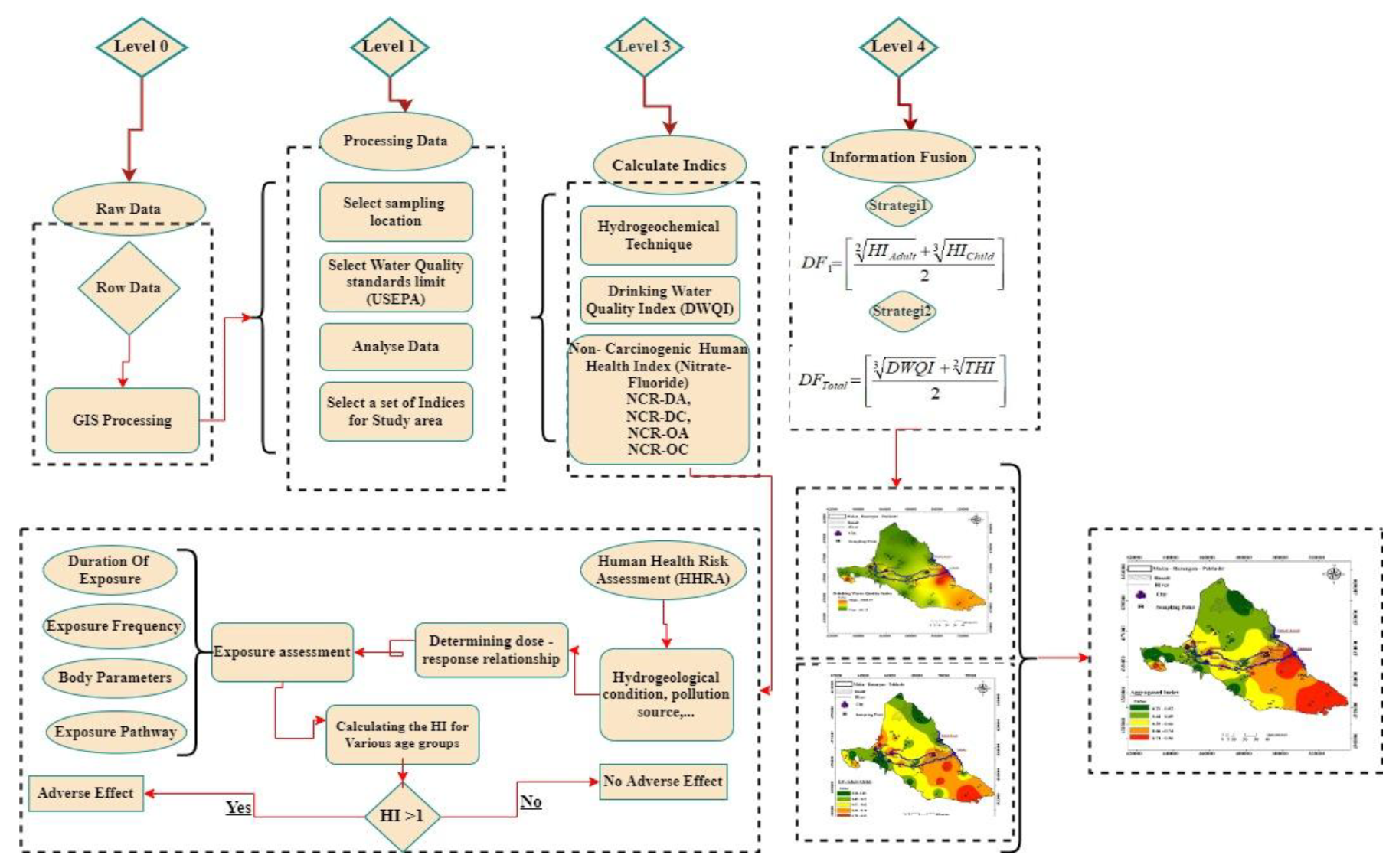
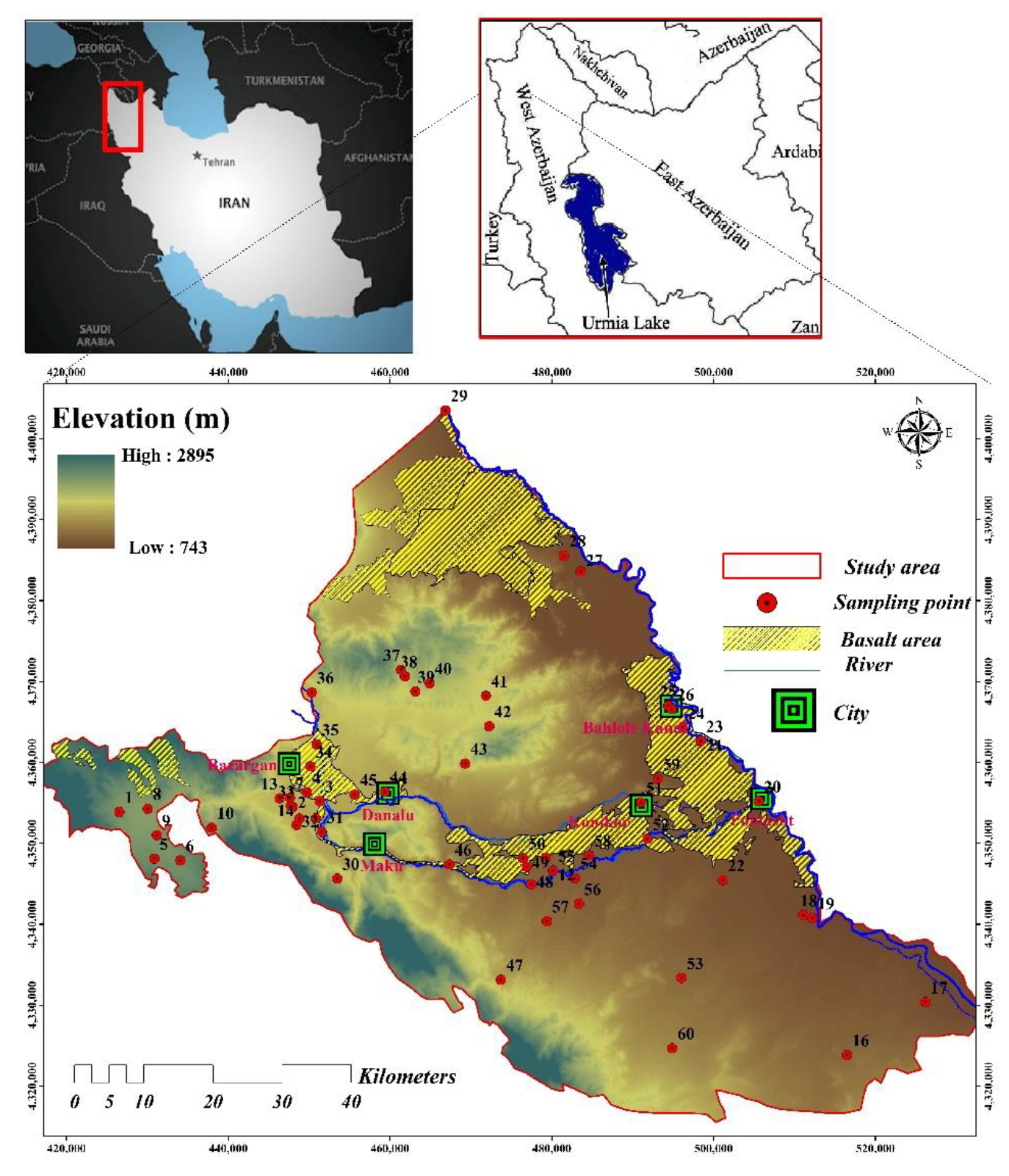

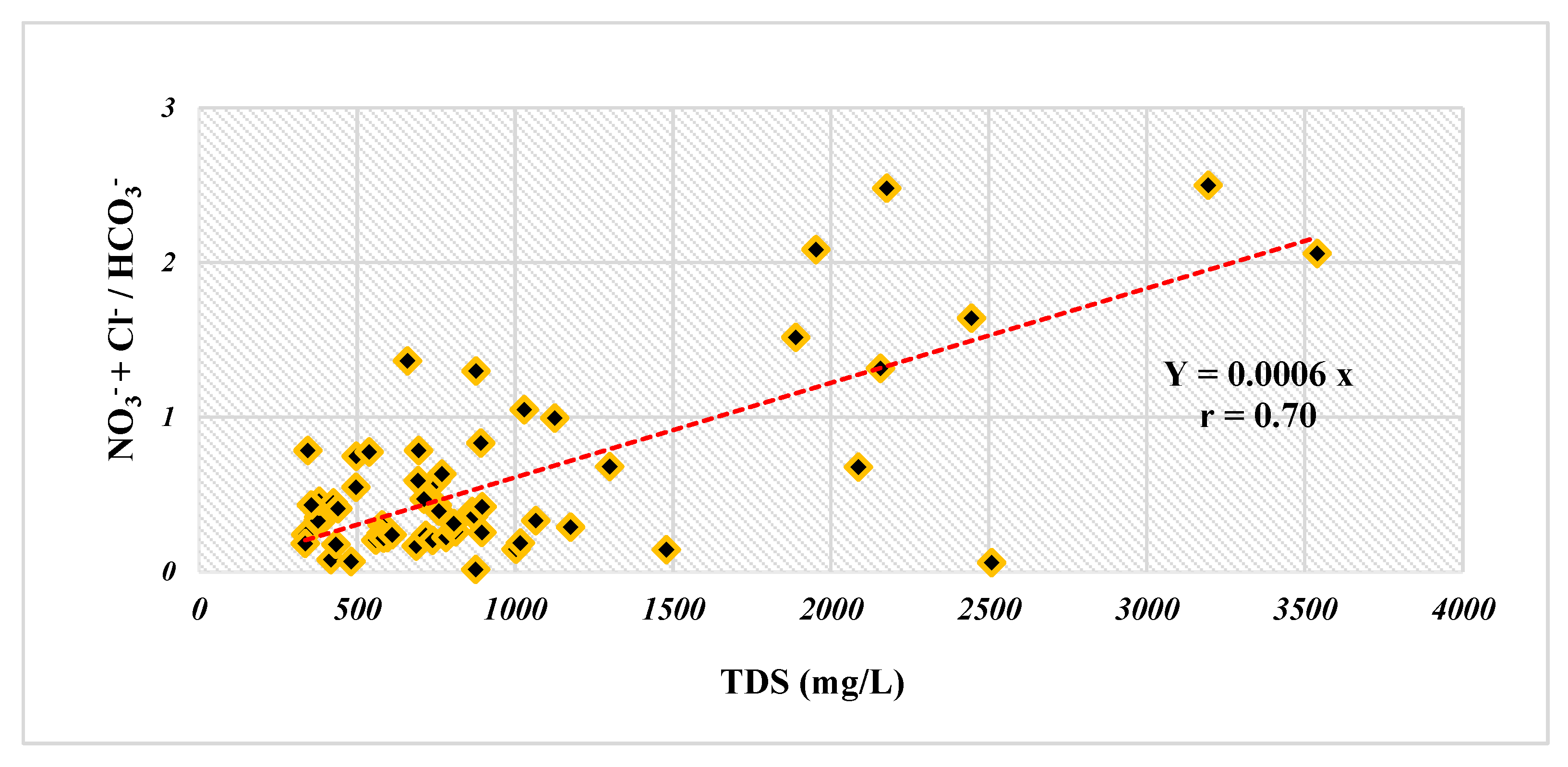
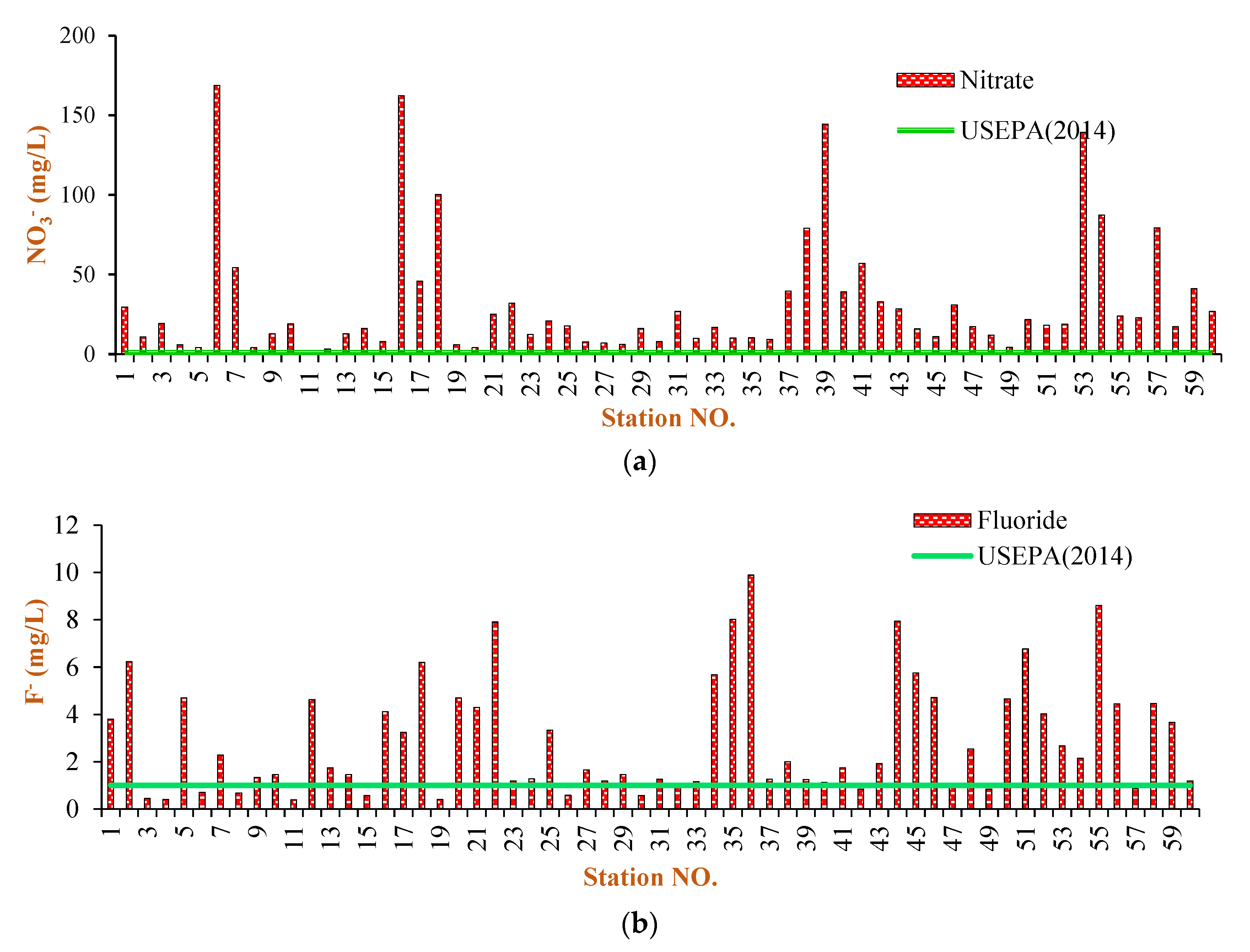
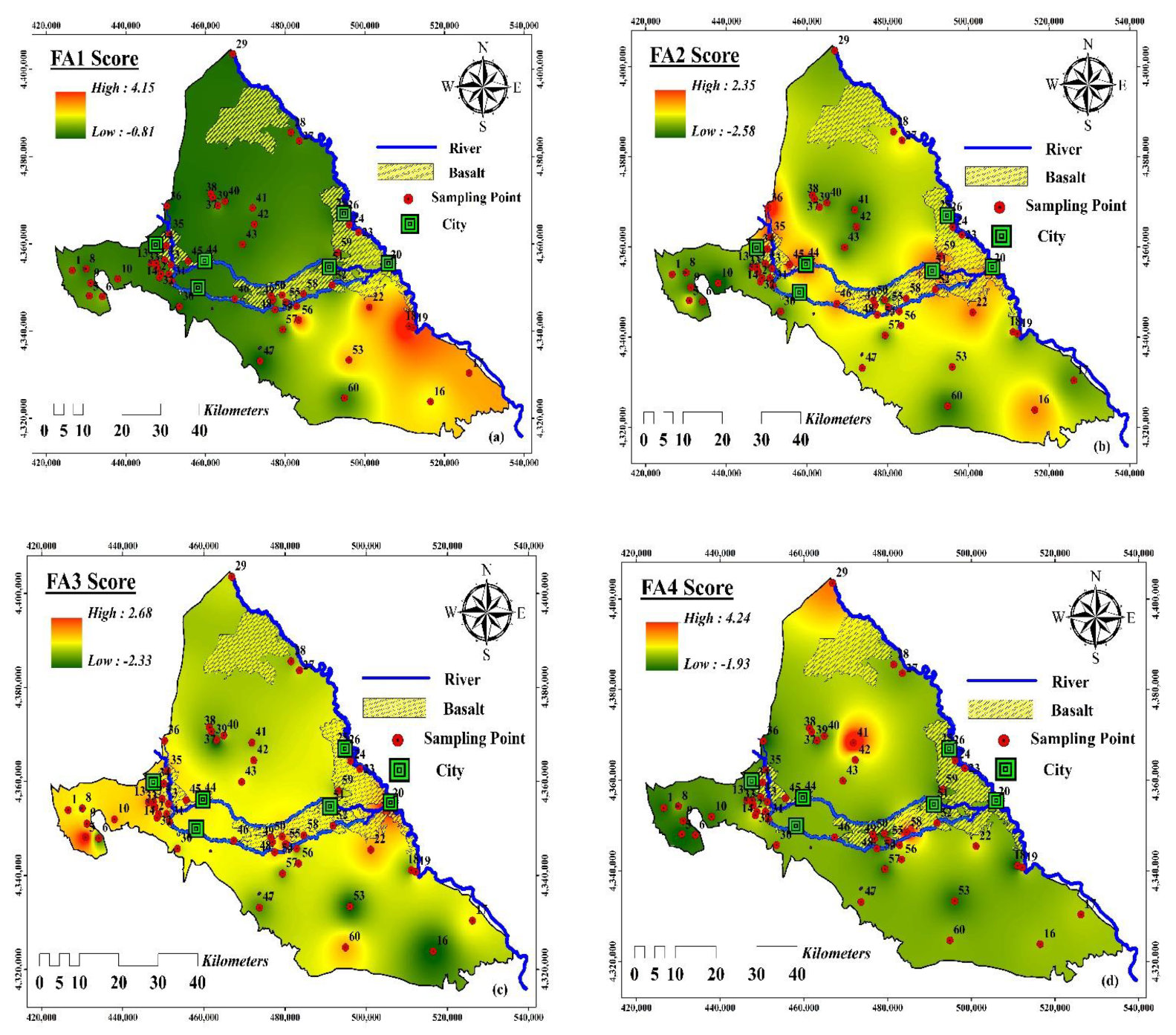

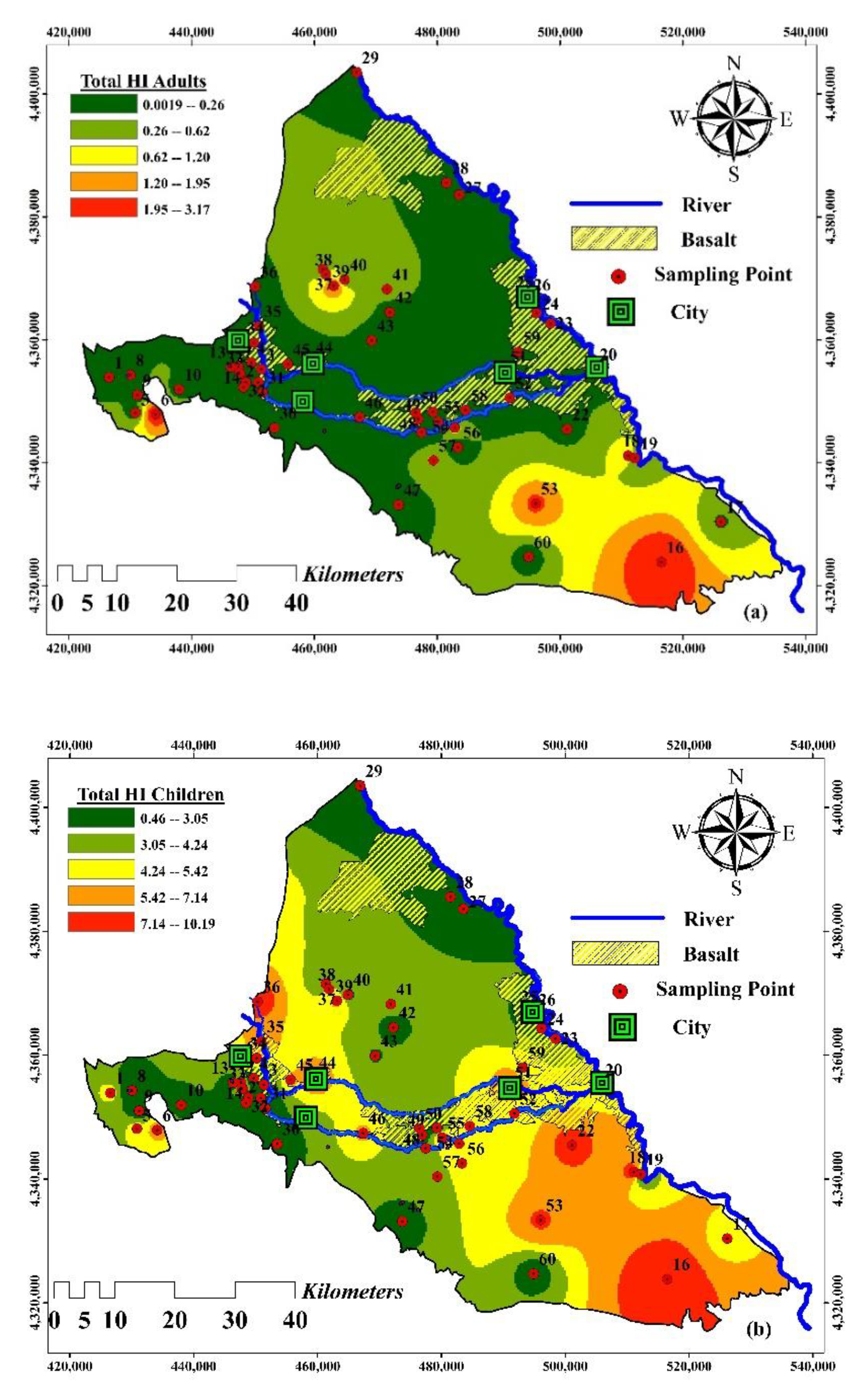


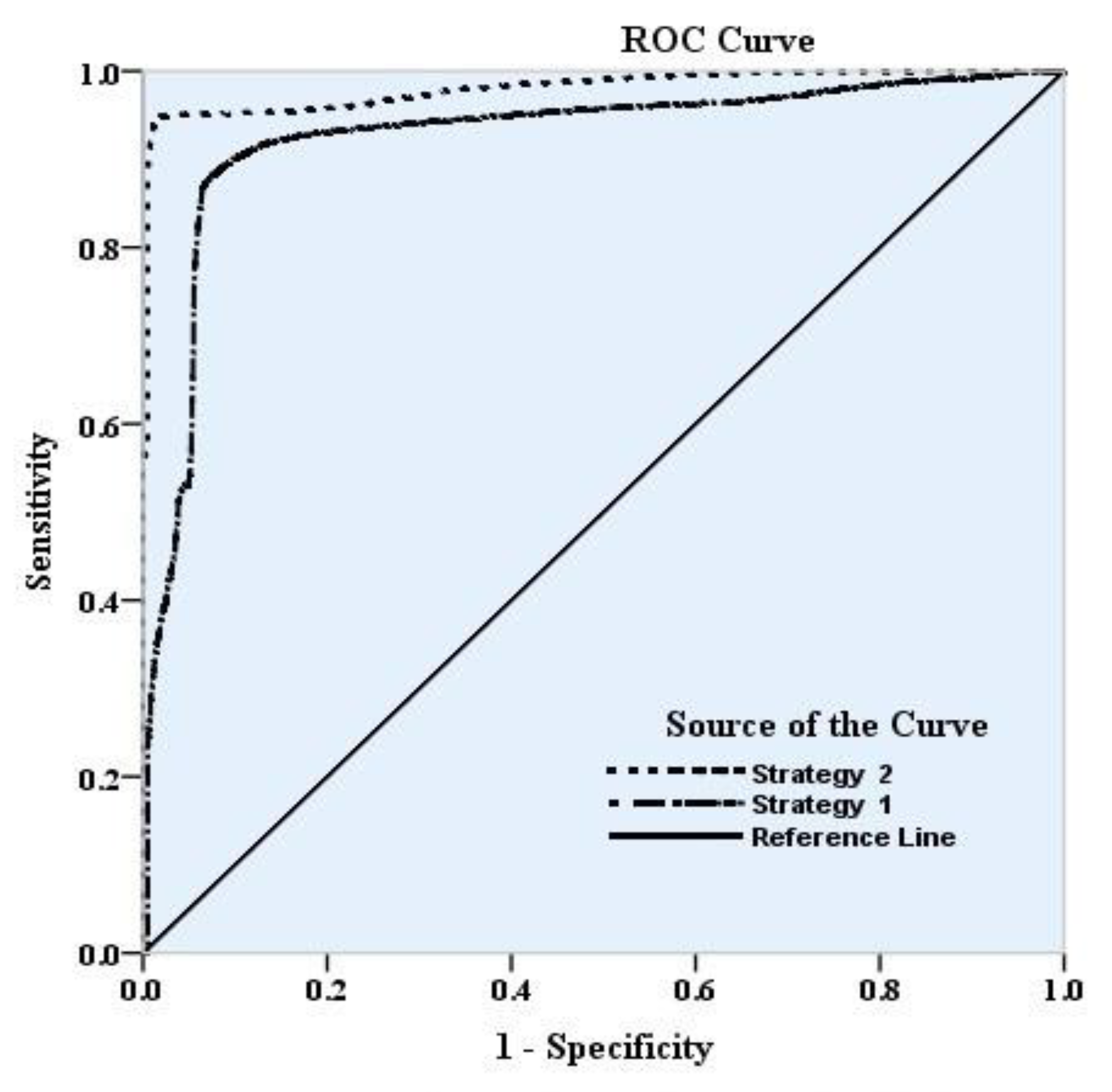
| Name of Index | Sources | Elements | Methods | Rational Classification (Proposed Classification) for Drinking Water | Application Areas | ||||
|---|---|---|---|---|---|---|---|---|---|
| Major Ions | Minor Ions | Properties | DWQI | HRA | Information Fusion | ||||
| HHRI | [20] | * | * | * | * | Non-carcinogenic health risk assessment of nitrate in bottled drinking water sold | |||
| GIS Base | [21] | * | * | * | * | Calculated HR from NO3− in drinking water using the Water Quality Index | |||
| GIS, mathematical base | [22] | * | * | * | * | Assessed hazard index, water resources quality, and hydrochemical analysis using a multivariate method | |||
| GQI/FGQI | [23] | * | * | * | Proposed a new hybrid framework combining GQI with Fuzzy Logic to examine groundwater quality and its spatial variability. | ||||
| HHRI | [24] | * | Examined heavy metal contents and evaluated HHRI | ||||||
| HHRI/WQI | [25] | * | * | * | * | Evaluated based on carcinogenic and non-carcinogenic aspects. | |||
| FHI | [26] | * | * | * | * | Studied trace elements’ health risk in drinking water based on the Water Quality Index | |||
| HHRI/EWQI | [27] | * | * | * | * | * | Evaluated the HHRI of F− concentration in groundwater resources based on fuzzy logic approach | ||
| WQI/HHR | [28] | * | * | * | * | * | Water quality index and human health risk from NO3− and fluoride | ||
| Information-Fused Technique | Current study | * | * | * | * | * | * | * | Water resources contamination; NO3− contamination; water quality distribution; health risk |
| Parameter | Units | Range | Mean | Standard Deviation | US EPA | Type of Problem | Samples Exceeded US EPA Limit |
|---|---|---|---|---|---|---|---|
| October 2021 | |||||||
| Institute measurements | |||||||
| EC | μS/cm | 525–5530 | 1503.9 | 1099.27 | 1000 | 62% | |
| pH | - | 6.7–8.37 | 7.37 | 0.37 | 7.5 | 28% | |
| Major Elements | |||||||
| Na+ | mg/L | 16–1001 | 221.39 | 217.63 | 200 | 40% | |
| K+ | mg/L | 3–70 | 12.44 | 10.15 | 12 | 45% | |
| Ca2+ | mg/L | 32–518 | 102.70 | 82.68 | 200 | 9% | |
| Mg+ | mg/L | 11–245 | 65.68 | 51.56 | 30 | 81% | |
| Cl− | mg/L | 4–770 | 132.02 | 162.25 | 250 | 17% | |
| SO42− | mg/L | 6–9079 | 479.21 | 1263.94 | 250 | 20% | |
| HCO3− | - | 107–537 | 265.59 | 109.48 | 300 | - | |
| F− | mg/L | 0.39–10 | 2.94 | 2.43 | 1.5 | Caused fluorosis | 48.33% |
| Br− | mg/L | 0–1 | 2.78 | 4.74 | 0.1 | 83.3% | |
| Nutrients | |||||||
| NO3− | mg/L | 0.23–169 | 32.22 | 39.04 | 10 | Methemoglobinemia | 75% |
| NO2− | mg/L | 0–5 | 0.32 | 0.86 | 3 | 4% | |
| NH4+ | mg/L | 0–4 | 1.05 | 1.05 | 0.05 | 76.6% | |
| Corresponding Effects on Human Health Risk Assessment | Concentration (mg/L) | Station No. | % of the Samples | |
|---|---|---|---|---|
| F− | Safe limit | <1 | 3, 4, 6, 8, 11, 15, 19, 26, 30, 32, 42, 49, 57 | 21.6% |
| Dental Fluorosis | 1–3 | 7, 9, 10, 13, 14, 23, 24, 27, 28, 29, 31, 33, 37, 38, 39, 40, 41, 43, 47, 48, 53, 54, 60 | 38.3% | |
| Stiff and fragile Bones/Joints | 3–4 | 1, 17, 25, 59 | 6.6% | |
| Defects in knees; crippling fluorosis; bones conclusively paralyzed resulting in incapability to walk or stand straight | >4 | 2, 5, 12, 16, 18, 20, 21, 22, 34, 35, 36, 44, 45, 46, 50, 51, 52, 55, 56, 58 | 33% | |
| NO3− | Safe limit | <10 | 4, 5, 8, 11, 12, 15, 19, 20, 26, 27, 28, 30, 32, 36, 49 | 25% |
| Health risk | 10–50 | 1, 2, 3, 9, 10, 13, 14, 17, 21, 22, 23, 24, 25, 29, 31, 33, 34, 35, 37, 40, 42, 43, 44, 45, 46, 47, 48, 50, 51, 52, 55, 56, 58, 59, 60 | 58% | |
| High health risk | 50–100 | 7, 38, 41, 54, 57 | 8.3% | |
| Very high health risk | >100 | 6, 16, 18, 39, 53 | 8.3% |
| EC | pH | Na+ | NH4+ | K+ | Ca2+ | Mg2+ | F− | Cl− | NO2− | Br− | NO3− | SO42− | HCO3− | |
|---|---|---|---|---|---|---|---|---|---|---|---|---|---|---|
| EC | 1 | |||||||||||||
| pH | −0.27 | 1 | ||||||||||||
| Na+ | 0.95 ** | −0.29 * | 1 | |||||||||||
| NH4+ | 0.45 ** | −0.23 * | 0.56 ** | 1 | ||||||||||
| K+ | 0.66 ** | −0.29 * | 0.73 ** | 0.22 | 1 | |||||||||
| Ca2+ | 0.87 ** | −0.31 * | 0.76 ** | 0.25 | 0.63 ** | 1 | ||||||||
| Mg2+ | 0.91 ** | −0.25 | 0.82 ** | 0.33 | 0.56 ** | 0.85 ** | 1 | |||||||
| F− | 0.38 ** | −0.16 | 0.52 ** | 0.41 ** | 0.46 ** | 0.18 | 0.16 | 1 | ||||||
| Cl− | 0.75 ** | −0.44 ** | 0.72 ** | 0.33 * | 0.44 ** | 0.71 * | 0.65 ** | 0.40 ** | 1 | |||||
| NO2− | −0.09 | −0.04 | −0.09 | −0.006 | −0.07 | −0.11 * | −0.06 | 0.04 | −0.08 | 1 | ||||
| Br− | 0.33 ** | −0.08 | 0.39 ** | 0.25 | 0.27 * | 0.13 | 0.18 | 0.35 ** | 0.15 | −0.07 | 1 | |||
| NO3− | 0.26 * | −0.30 * | 0.17 | −0.16 | 0.22 | 0.26 * | 0.35 ** | −0.06 | 0.34 ** | −0.003 | −0.04 | 1 | ||
| SO42− | 0.30 * | −0.009 | 0.25 * | 0.02 | 0.19 | 0.34 ** | 0.31 * | 0.04 | 0.31 * | −0.07 | −0.01 | 0.05 | 1 | |
| HCO3− | 0.25 * | −0.35 ** | 0.37 ** | 0.26 * | 0.36 ** | 0.05 | 0.04 | 0.71 ** | 0.35 ** | −0.09 | 0.17 | −0.05 | −0.07 | 1 |
| Parameters | Factor 1 | Factor 2 | Factor 3 | Factor 4 |
|---|---|---|---|---|
| EC | 0.94 | 0.23 | 0.032 | 0.026 |
| pH | −0.2 | −0.44 | 0.62 | −0.22 |
| Na+ | 0.87 | 0.42 | 0.12 | 0.046 |
| NH4+ | 0.38 | 0.41 | 0.37 | 0.3 |
| K+ | 0.64 | 0.40 | −0.05 | −0.10 |
| Ca2+ | 0.91 | 0.023 | −0.13 | −0.03 |
| Mg2+ | 0.93 | −0.006 | −0.081 | 0.049 |
| F− | 0.22 | 0.82 | 0.23 | −0.02 |
| Cl− | 0.74 | 0.34 | −0.23 | −0.003 |
| NO2− | −0.08 | −0.11 | −0.06 | 0.87 |
| Br− | 0.28 | 0.27 | 0.55 | −0.07 |
| NO3− | 0.32 | −0.06 | −0.67 | −0.08 |
| SO42− | 0.50 | −0.23 | 0.068 | −0.23 |
| HCO3− | 0.029 | 0.90 | −0.058 | −0.085 |
| % of Variance | 35.86 | 18.07 | 10.45 | 7.51 |
| Cumulative % | 35.86 | 53.93 | 64.39 | 71.9 |
| Samples | Non-Carcinogenic | DWQI Classify | Samples | Non-Carcinogenic | DWQI | ||||||
|---|---|---|---|---|---|---|---|---|---|---|---|
| Adults | Child | Value | Conventional | Rational (Proposed Classification) | Adults | Child | Value | Conventional | Rational (Proposed Classification) | ||
| 1 | 3.73 | 3.57 | 102.2 | Poor | Poor | 31 | 1.67 | 1.78 | 209.2 | Unsuitable | Poor |
| 2 | 5.17 | 4.54 | 1057.5 | Unsuitable | Unsuitable | 32 | 0.96 | 0.9 | 167.3 | Poor | Poor |
| 3 | 0.84 | 0.97 | 100.8 | Poor | Good | 33 | 1.33 | 1.35 | 235.2 | Unsuitable | Poor |
| 4 | 0.47 | 0.48 | 150.1 | Poor | Poor | 34 | 4.72 | 4.14 | 506.9 | Unsuitable | Poor |
| 5 | 3.79 | 3.27 | 1812.9 | Unsuitable | Unsuitable | 35 | 6.56 | 5.71 | 518 | Unsuitable | Poor |
| 6 | 4.83 | 6.39 | 636.2 | Unsuitable | Unsuitable | 36 | 8.01 | 6.92 | 213 | Unsuitable | Poor |
| 7 | 3.16 | 3.42 | 268.7 | Unsuitable | Poor | 37 | 1.99 | 2.23 | 211.9 | Unsuitable | Poor |
| 8 | 0.64 | 0.60 | 104.5 | Poor | Good | 38 | 3.57 | 4.10 | 263.8 | Unsuitable | Poor |
| 9 | 1.37 | 1.34 | 64.9 | Good | Good | 39 | 4.63 | 5.90 | 343.9 | Unsuitable | Poor |
| 10 | 1.62 | 1.63 | 69.6 | Good | Good | 40 | 1.87 | 2.12 | 205.06 | Unsuitable | Poor |
| 11 | 0.31 | 0.26 | 695.7 | Unsuitable | Unsuitable | 41 | 2.81 | 3.16 | 296 | Unsuitable | Poor |
| 12 | 3.72 | 3.20 | 1576.7 | Unsuitable | Unsuitable | 42 | 1.49 | 1.71 | 160.6 | Poor | Poor |
| 13 | 1.69 | 1.61 | 335.5 | Unsuitable | Poor | 43 | 2.22 | 2.27 | 245.6 | Unsuitable | Poor |
| 14 | 1.55 | 1.54 | 252.7 | Unsuitable | Poor | 44 | 6.64 | 5.85 | 877.1 | Unsuitable | Unsuitable |
| 15 | 0.65 | 0.66 | 51.1 | Good | Good | 45 | 4.80 | 4.22 | 578.5 | Unsuitable | Unsuitable |
| 16 | 7.35 | 8.44 | 971.8 | Unsuitable | Unsuitable | 46 | 4.49 | 4.23 | 679.7 | Unsuitable | Unsuitable |
| 17 | 3.71 | 3.78 | 871.9 | Unsuitable | Unsuitable | 47 | 1.26 | 1.30 | 109 | Poor | Good |
| 18 | 7.41 | 7.65 | 707.14 | Unsuitable | Unsuitable | 48 | 2.29 | 2.11 | 392.8 | Unsuitable | Poor |
| 19 | 0.47 | 0.48 | 714.7 | Unsuitable | Unsuitable | 49 | 0.76 | 0.71 | 330.5 | Unsuitable | Poor |
| 20 | 3.79 | 3.27 | 2211.3 | Unsuitable | Unsuitable | 50 | 4.20 | 3.86 | 513.4 | Unsuitable | Poor |
| 21 | 4.01 | 3.75 | 1171.6 | Unsuitable | Unsuitable | 51 | 5.79 | 5.16 | 443.7 | Unsuitable | Poor |
| 22 | 7.01 | 6.38 | 1475.2 | Unsuitable | Unsuitable | 52 | 3.63 | 3.34 | 579.8 | Unsuitable | Unsuitable |
| 23 | 1.24 | 1.23 | 352.8 | Unsuitable | Poor | 53 | 5.62 | 6.67 | 588.4 | Unsuitable | Unsuitable |
| 24 | 1.52 | 1.57 | 233 | Unsuitable | Poor | 54 | 3.90 | 4.50 | 627.4 | Unsuitable | Unsuitable |
| 25 | 3.07 | 2.85 | 332.6 | Unsuitable | Poor | 55 | 7.36 | 6.5 | 724.05 | Unsuitable | Unsuitable |
| 26 | 0.65 | 0.65 | 105.3 | Poor | Good | 56 | 4.07 | 3.77 | 987.5 | Unsuitable | Unsuitable |
| 27 | 1.47 | 1.34 | 354.3 | Unsuitable | Poor | 57 | 2.67 | 3.35 | 109.8 | Poor | Good |
| 28 | 1.08 | 1.00 | 65 | Good | Good | 58 | 3.94 | 3.57 | 695.6 | Unsuitable | Unsuitable |
| 29 | 1.55 | 1.54 | 221.2 | Unsuitable | Poor | 59 | 3.92 | 3.89 | 655.4 | Unsuitable | Unsuitable |
| 30 | 0.65 | 0.66 | 101.3 | Poor | Good | 60 | 1.61 | 1.73 | 338.8 | Unsuitable | Poor |
| Index | Class | NO3− concentration | CI | F− concentration | CI | ||||||
| Safe (<10 mg/L) | Health Risk (10–50 mg/L) | High Health Risk (>50 mg/L) | Safe (<1 mg/L) | Florsis (Dental–Bones) (1–4 mg/L) | Defects in knees; crippling fluorosis (>4 mg/L) | ||||||
| Rational (proposed classification) | Good | 3 | 5 | 5 | 144 | 4 | 6 | 3 | 155 | ||
| Poor | 4 | 21 | 11 | 4 | 19 | 4 | |||||
| Unsuitable | 1 | 4 | 6 | 0 | 5 | 15 | |||||
| Conventional | Good | 2 | 4 | 7 | 94 | 1 | 8 | 4 | 139 | ||
| Poor | 2 | 5 | 29 | 3 | 2 | 22 | |||||
| Unsuitable | 0 | 1 | 10 | 0 | 0 | 20 | |||||
| Test Result Variable(s) | Area | Std. Error a | Asymptotic Sig. b | 95% Confidence Interval | |
|---|---|---|---|---|---|
| Lower Bound | Upper Bound | ||||
| Strategy 1 | 0.92 | 0.003 | 0.00 | 0.92 | 0.93 |
| Strategy 2 | 0.98 | 0.001 | 0.00 | 0.97 | 0.98 |
Publisher’s Note: MDPI stays neutral with regard to jurisdictional claims in published maps and institutional affiliations. |
© 2022 by the authors. Licensee MDPI, Basel, Switzerland. This article is an open access article distributed under the terms and conditions of the Creative Commons Attribution (CC BY) license (https://creativecommons.org/licenses/by/4.0/).
Share and Cite
Nadiri, A.A.; Sedghi, Z.; Barzegar, R.; Nikoo, M.R. Establishing a Data Fusion Water Resources Risk Map Based on Aggregating Drinking Water Quality and Human Health Risk Indices. Water 2022, 14, 3390. https://doi.org/10.3390/w14213390
Nadiri AA, Sedghi Z, Barzegar R, Nikoo MR. Establishing a Data Fusion Water Resources Risk Map Based on Aggregating Drinking Water Quality and Human Health Risk Indices. Water. 2022; 14(21):3390. https://doi.org/10.3390/w14213390
Chicago/Turabian StyleNadiri, Ata Allah, Zahra Sedghi, Rahim Barzegar, and Mohammad Reza Nikoo. 2022. "Establishing a Data Fusion Water Resources Risk Map Based on Aggregating Drinking Water Quality and Human Health Risk Indices" Water 14, no. 21: 3390. https://doi.org/10.3390/w14213390
APA StyleNadiri, A. A., Sedghi, Z., Barzegar, R., & Nikoo, M. R. (2022). Establishing a Data Fusion Water Resources Risk Map Based on Aggregating Drinking Water Quality and Human Health Risk Indices. Water, 14(21), 3390. https://doi.org/10.3390/w14213390









